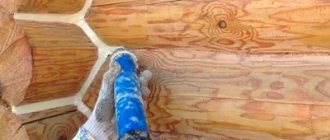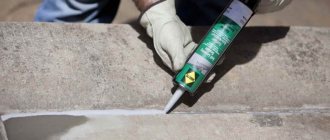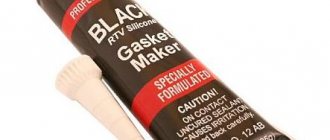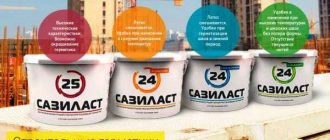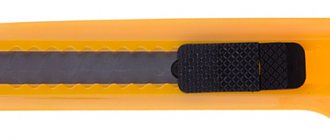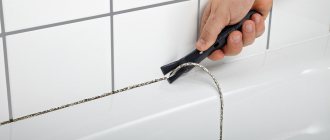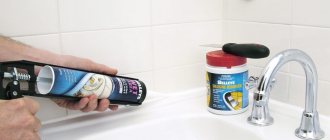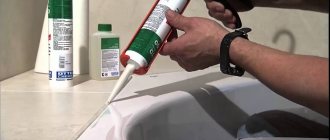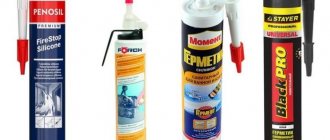What is bitumen sealant used for?
It doesn’t matter at all what type of roof you use, all elements must be sealed together in any case. This is done in order to protect the attic from cold bridges, oxidation of metal structures and moisture accumulation on the rafter system. A moisture-resistant vapor barrier layer must be installed under the roof.
All roof sealants are divided into 4 types:
- bitumen;
- silicone;
- acrylic;
- polyurethane.
Operating a cartridge and a construction gun
The sequence of operations will be as follows:
- The cartridge is cut above the threads.
- The spout is screwed on. It is cut at an angle so that the hole is equal to the width of the joint or gap.
- Now the cartridge is installed in the construction gun.
- The sealant is applied to the edges of the joining elements in stripes or dots.
- If it is necessary to process deep seams, joints or holes, then the sealant is applied in several layers, allowing each previous layer to harden.
- If the gaps being treated are quite wide, then a polypropylene cord should be laid between the two layers of sealant.
Composition of bitumen sealant
Natural bitumens are considered the main components of oil, which are formed during the primary temperature distillation of petroleum products. This common petroleum derivative has been used by humanity for hundreds of years; at the moment, bitumen is mainly used in finishing work and construction.
Artificial bitumen is made using coal, shale and various additives. Such bitumen does not deteriorate at all under constant exposure to water. Therefore, this composition is suitable for insulating any materials, be it stone, wood, metal or plastic.
Operating principle
Bitumen in its natural environment is a derivative of oil. This mountain resin has been used for many centuries as a finishing or building material. With its help, wood was processed and mosaics were created.
And artificial bitumen is produced on the basis of materials such as:
- slate;
- oil;
- coal.
The material does not dissolve in water; accordingly, it has a water-repellent property and is amorphous. Due to its “fluidity” it is easily applied to any surface and has good adhesion to various materials. For this reason, it comes into excellent contact with the following materials:
- stone;
- concrete;
- tree;
- metal;
- brick.
The sealant works effectively at ambient temperature conditions from -40 to +90 degrees. Resistant to aggressive chemical environments and ultraviolet radiation.
Types of roofing sealants
Bitumen-rubber
Bitumens that were produced on the basis of artificial rubbers have the following qualities:
- the sealant may break under dynamic loads, provided that the ambient temperature drops below -40°C;
- increased strength compared to other bitumen mixtures;
- plastic;
- service life without loss of basic qualities 8-10 years;
- The sealant can be used without additional heating.
Bitumen-polymer
Bituminous sealant is improved with the following additives:
- a whole group of copolymers of divinyl and heat-resistant styrene;
- thermoplastics;
- thermosets created on the basis of urea resins.
This composition is characterized by the longest service life, excellent elasticity, and resistance to high temperatures.
Bitumen-mineral
Powders from various minerals or synthetic fibers are added to this composition. They are used to fully fill voids, therefore adhesion to the roofing material increases.
Sealants are produced using mineral additives in the form of: paste, emulsion, tape and mastic. The emulsion is used only if you need to improve the adhesive properties of a similar sealant.
Note! If you want to improve the adhesion of the sealant to any material, then you can purchase a primer for asphalt sealant. It is advisable to purchase a primer from the same manufacturer as the sealant itself, then you will be sure of the compatibility of the chemical compositions.
Characteristics of bitumen-based sealant
The following characteristics of bitumen sealant for metal roofing can be distinguished:
- main substance: bitumen;
- auxiliary elements: artificial rubber, thermoplastics, thermosets and block copolymers;
- softening inclusions: gasoline, kerosene, naphtha, etc.;
- elements that impart plasticity: tar, industrial or anthracene oil;
- inclusions to impart adhesive properties: cationic substances;
- strengthening and structure-forming elements: polymer, mineral or cellulose fibers;
- Application temperature: 5-30 ºC.
- film formation period: half an hour.
- hardening time: 0.5 mm per day.
- thermal stability in solid state: -43 - 90 ºC.
Pros and cons of bitumen sealant
pros
- The sealing composition adheres firmly to any materials (provided that they are not covered with dust or moisture).
- Does not lose its properties even with frequent interaction with water.
- The composition has a huge service life, approximately 10-20 years (this parameter largely depends on the type of sealant).
- When in contact with metal structural elements, the sealant does not trigger the process of metal oxidation.
- The sealant sets in literally 2-3 minutes.
- The sealant does not shrink and does not lose its original shape over time.
- Mold and mildew will not form at the joints, since bitumen resin is initially an unfavorable environment for any life activity.
- Has a low cost.
Minuses
- Many compounds emit toxic substances, so it is permissible to use bitumen sealant only outside the house.
- The sealant burns well, but this is not entirely good from the point of view of the fire safety of the roof.
- The composition softens when the roof warms up above 70 degrees, this is especially bad if the strong heating of the roof coincides with gusty winds. In this case, there is a high probability of depressurization of some joints of the roofing material.
- When laying a porous roof, be sure to use a primer for better adhesion.
Helpful advice!
If you have a lot of small roofing fragments, then in this case it is better to buy bitumen sealant in a large can. It can be applied conveniently and quickly using a spatula.
Calculation of the amount of sealant required
In order to fill 1 cm3 of space, 1 ml plus 30% of roofing polyurethane sealant will be required. To calculate the volume of a seam, you need to multiply its depth, width and length.
What is the maximum size a seam can be when filling it with sealant?
Silicone roofing sealant, in theory, can seal seams up to 30 mm wide. Remember that the width of the seam should not exceed the depth by more than 2 times.
When deciding which roofing sealant is best suited for sealing joints, you can pay attention to the following brands: Titan, TechnoNIKOL, Germent, Soudal, Macroflex, Moment.
How to use bitumen sealant
During the work process, you should adhere to the following recommendations:
- The use of sealant is allowed exclusively for external work, since some compositions contain dangerous compounds with formaldehyde.
- Before use, the container with sealant should lie at room temperature for a whole day, or preferably two.
- Bituminous compounds are highly flammable and burn, so they cannot be used to seal fire-hazardous areas of the roof.
- When working with sealant, be sure to wear safety glasses and rubber gloves.
- If you apply the sealant with a spatula, then prepare a small container with soapy water; it is necessary so that the sealant can easily come off the tool.
- If you have stained the facade of the house or something else with sealants, you can remove it with a clean cloth soaked in a solvent.
Important! Before starting work, you must make sure that there is no water or dust on the roofing material; only in this case the manufacturer guarantees the tightness of the joints. If there is still moisture and dust on the roof, then they need to be removed using a compressor with compressed air.
What kind of work is sealant used for at airports?
On airfield pavements, seams are sealed during repair and restoration work or new construction:
- repair of an expansion joint on a monolithic reinforced concrete base;
- construction of working and expansion joints;
- sealing seams of prefabricated airfield pavements;
- conservation of cracks and repair of chips in reinforced concrete pavement;
- preservation of cracks on asphalt concrete pavement.
Repairing or installing an expansion joint consists of cutting a groove, laying a sealant and sealant.
Photo of bitumen sealant
Terms of use
Since the product is flammable, you must follow fire safety rules and avoid getting the composition on your skin.
And don't forget to wear protective gloves. The composition can be applied using a construction gun, and it is leveled using a spatula dipped in soapy water. Sealants are removed after work using white spirit, and if they have hardened, then only mechanically. For this reason, all surfaces and tools should be cleaned with solvent immediately after sealing is completed.
Before work, you need to properly prepare the surface. It should be cleaned of dirt:
Sealant is applied to the edges of the surfaces to be glued in strips or dots.
If deep seams, holes or joints are filled, then it is applied in layers , each time allowing the previous layer to dry.
And if the gaps are wide, then you need to put a polypropylene cord between the two layers. If the composition is applied in large volumes, you will additionally need a trowel and a spatula, with which it can be easily collected from a jar or bucket. It is necessary that the corners of the tools are rounded and the working substance does not stick; to do this, they are moistened with a soap solution.
You also need to calculate the sealant consumption before work.
So, 1 ml of product is required to fill 1 cubic centimeter. To determine the volume of the seam, you need to multiply its length, width and depth by each other. For example, to fill a seam one meter long and 10 mm wide and deep, you will need 10 ml of product.
Add another 30 percent to the resulting figure, since the sealant cannot be applied flush. The maximum permissible seam size is 30 mm wide. It is very important to follow the “two depths” rule, according to which the width should not be more than half the depth. The deeper the seam, the longer the sealant will take to harden.
Adhesive sealant for seams white
CEMMIX Adhesive-sealant for seams is a one-component polyurethane sealant for sealing various seams, junctions of steps and walls, entry of pipes and ventilation systems and rigid-elastic gluing of various materials.
More details
No. 9. What must be taken into account when choosing a sealant?
Naturally, before going to the store, you need to clearly understand where and under what conditions the sealant will be used. If it is a bathtub, then a moisture-resistant composition is required; if it is a wooden floor, then the sealant must be elastic and not contain solvents. In addition, pay attention to what is indicated on the packaging:
- area of application of the composition (external or internal work);
- type of work performed (roofing, window, plumbing, etc.);
- the manufacturer must indicate for what types of surfaces the sealant is intended, as well as whether it is elastic or not;
- composition color. If the sealant cannot be painted or simply will not be painted, its color is important so that aesthetics are not compromised;
- sealants can be household or professional, the latter are more difficult to use;
- pay attention to the indicated operating temperatures of the composition, comparing them with the existing climate characteristics in the region.
Adhesive sealant for seams white
CEMMIX Adhesive-sealant for seams is a one-component polyurethane sealant for sealing various seams, junctions of steps and walls, entry of pipes and ventilation systems and rigid-elastic gluing of various materials.
More details
Examples of reliable modern polyurethane sealants are Cemmix Heavy-Duty Roofing Adhesive-Sealant, Cemmix Seam Adhesive-Sealant and Cemmix Weather-Resistant Facade Adhesive-Sealant:
- designed for seams up to 20 mm wide;
- easy to apply (thixotropic, does not bubble or spread);
- allow work to be carried out at air temperatures from minus 40°С to plus 40°С, application to wet surfaces, work in conditions of fog and rain;
- quickly cure under the influence of atmospheric moisture;
- universal;
- elastic;
- waterproof;
- resistant to any weather conditions;
- exhibit resistance to vibration;
- do not support the growth of bacteria and fungi;
- have high adhesion to metal and any types of materials (porous, including);
- chemically inert;
- durable;
- serve from 10 to 25 years;
- have a wide range of operating temperatures;
- allow coloring;
- Cemmix facade adhesive-sealant and Cemmix adhesive-sealant for seams are available in several color shades.
What is a primer and how to use it?
It is a water emulsion of high quality petroleum bitumen using organic solvents. It has a number of positive properties: it penetrates deeply into the pores of the base, binds dust particles, improves adhesion, dries quickly, and does not stick. It is produced in the form of a concentrate, which reduces its cost.
Before use, dilute according to the instructions, taking into account the characteristics of the surface to be coated. Apply with a roller or brush. Drying time – 1 hour.
Bitumen-polymer sealant
Bitumen-polymer sealant is used when:
- They seal expansion joints on asphalt and concrete surfaces of a highway or runway.
- Seal cracks in concrete or asphalt coatings.
Compound
This hot sealant contains:
- petroleum bitumen;
- modified synthetic rubber;
- technological additives.
Properties
The use of bitumen-polymer sealant in the most critical places is due to its properties, namely:
- Wide range of temperatures at which it can be used. Store at temperatures from -20 to +30 C. Operating temperature from 160 to 190 C. Softens at temperatures from 95 to 105 C.
- High elasticity. Under the influence of ultraviolet rays, its properties change by only 15% within 1000 hours.
- No shrinkage.
In different climatic zones it is recommended to use one of 3 modifications:
- BP-G25;
- BP-G35;
- BP-G50.
The bitumen-polymer sealant “Prestige”, which is produced by the Russian company, is worthy of attention. This material:
- one-component - black mass;
- wear-resistant. Withstands both significant temperature fluctuations and aggressive environments;
- adheres well to metal, stone, concrete.
Includes:
- polymers;
- petroleum road bitumens;
- plasticizers;
- adhesive additives.
It is used in the repair of roads and airfields.
The universal hot-use bitumen-polymer sealant TechnoNIKOL No. 42 from the domestic manufacturer TECHNONICOL is also widely known:
- all characteristics appear 1 hour after application;
- It can be used at different temperatures, which is a big advantage.
In the examples given, we were talking about hot-applied bitumen-polymer sealants, but there is another type - cold-applied. These include sealant-mastic BIOM-I. Releases material. Applicable for:
- sealing seams, both horizontal and vertical;
- sealing small cracks;
- installation of an independent waterproofing coating;
- laying roofing felt.
It is a sticky paste, very viscous, reinforced with polymer fiber.
